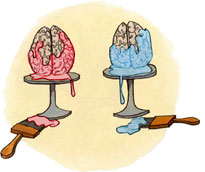
Here today is Adina Nack with a fantastic guest post on how STD stereotypes have led to the mismarketing of the HPV vaccine as a cervical cancer vaccine. An associate professor of sociology, who has directed California Lutheran University’s Center for Equality and Justice and their Gender and Women’s Studies Program, and author of Damaged Goods?, Adina asks some provocative questions about the consequences this gendered mislabeling will have for public health awareness. –Kristen
The “Cervical Cancer” Vaccine, STD Stigma & the Truth about HPVby Adina Nack
You’ve probably seen one of Merck‘s ads which promote GARDASIL as the first cervical cancer vaccine. Last year, their commercials featured teenage girls telling us they want to be “one less” woman with cervical cancer. GARDASIL’s website features new TV spots which say the vaccine helps prevent “other HPV diseases,” too, and end with, “You have the power to choose,” but do you, the viewer, know what you are choosing?
A clue that this is a STD vaccine appears briefly at the bottom of the screen: “HPV is Human Papillomavirus.” Merck’s goal may have been to appeal to parents who are squeamish about vaccinating their daughters against 4 types of virus which are almost always sexually transmitted. This marketing strategy means that the U.S. public, currently undereducated about HPV, is none the wiser about this family of viruses which infect millions in the U.S. and worldwide each year. When the ads briefly mention “other HPV diseases,” how many realize they’re talking about genital/anal warts and that recent studies link HPV with oral/throat cancers? [You don’t need to have a cervix (or even a vagina) to contract any of these “other” HPV diseases.] Why don’t they want us to know the whole truth about the vaccine?
Branding GARDASIL as a cervical cancer vaccine was aimed at winning public support. But, what are the consequences of a campaign built on half-truths? Today, only females, ages 9-26, can be protected against strains of a virus that may have serious consequences for boys/men and women past their mid-20s. If public health is the goal, then let’s question how our STD attitudes shaped a marketing plan which has, in turn, influenced drug policy.
Marketing a “cervical cancer” vaccine may have appeased some social conservatives who don’t want their daughters vaccinated against any STD, fearing it might promote premarital sex. But, the vaccine will likely soon be available to males, and their anatomy does not include a cervix — will girls get a “cervical cancer” vaccine and boys get a HPV vaccine? The current gender-biased policy supports a centuries old double-standard of sexual morality. Most view STD infections as more damaging to women than to men. Many believe that STDs result from promiscuity — girls/women deserve what they get. So, are we ready to embrace any STD vaccine (including a future HIV vaccine) as a preventive health measure?
Having studied women with HPV, I know that a person can contract the virus from nonconsensual sex or from their first sexual partner — you could still be a ‘technical’ virgin since skin-to-skin contact, not penetration, is the route of transmission. In my new book, Damaged Goods?, I take readers inside the lives of 43 women who have struggled to negotiate the stigma of having a chronic STD. One chapter delves into stereotypes about the types of people who get STDs: these beliefs not only skew our perceptions of STD risk (bad things only happen to bad people) but also can psychologically scar us if we contract one of those diseases. Merck’s branding of GARDASIL makes sense: a typical U.S. teenage girl or young woman has good reason to fear others’ judgments of her — thinking her to be promiscuous, dirty, naïve, and irresponsible — if they knew she’d sought out a STD vaccine. Whereas, getting a “cervical cancer” vaccine feels more like something that a responsible girl/woman would do.
Unfortunately, with GARDASIL taking the easy way out, the U.S. public misses a prime opportunity to learn about this prevalent, easily transmitted disease that is unfortunately difficult to test for. We’ve also lost a chance to take on STD stigma and challenge the population to view sexually transmitted infections as medical problems rather than as blemishes of moral character.
No vaccine is 100% effective and neither are the treatment options for HPV infections. STD stereotypes (particularly negative about infected women) come back to haunt those of us who become infected with diseases like HPV and herpes, which are treatable but not curable. Until there’s a ‘magic bullet’ cure, we should educate ourselves not only about medical facts but also about STD stigma — the anxiety, fear, shame and guilt — that often proves more damaging to the lives of those infected than the viruses, themselves.









